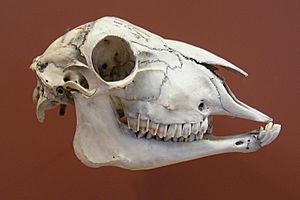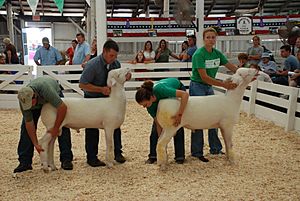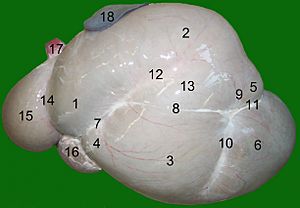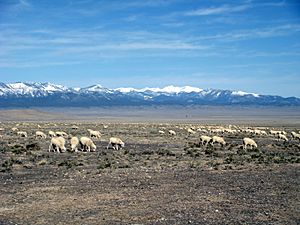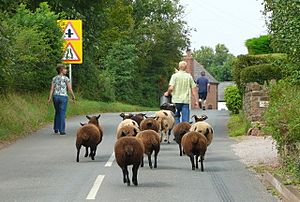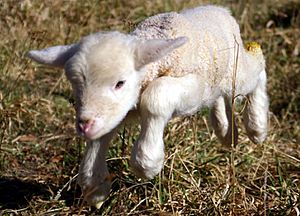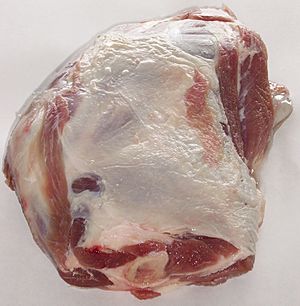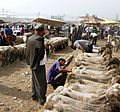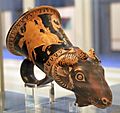Domestic sheep facts for kids
Quick facts for kids Domestic sheep |
|
|---|---|
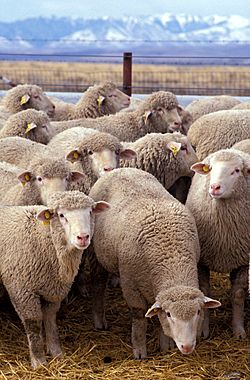 |
|
| A research flock at US Sheep Experiment Station near Dubois, Idaho | |
| Conservation status | |
| Scientific classification | |
| Kingdom: | |
| Phylum: | |
| Class: | |
| Order: | |
| Family: | |
| Subfamily: | |
| Genus: | |
| Species: |
O. aries
|
| Binomial name | |
| Ovis aries Linnaeus, 1758
|
|
A domestic sheep (Ovis aries) is a tamed mammal. It is related to wild sheep and goats. Female sheep are called ewes. Male sheep are called rams. Young sheep are called lambs.
People keep sheep for their wool and their meat. Sheep wool is cleaned and used to make clothes. The meat from young sheep is called lamb. Meat from adult sheep is called mutton. Both have been important foods for a very long time.
Sheep are animals that humans have bred over many years. There are different types, called breeds. Some breeds are best for wool, and others are best for meat.
The word "sheep" is special. The plural of "sheep" is also "sheep". So, one sheep or many sheep!
Contents
What Makes Sheep Special?
Domestic sheep are small ruminants. This means they have a special stomach with four parts. They usually have curly hair called wool. Many also have horns that spiral outwards.
Domestic sheep are different from their wild relatives. Humans have changed them through breeding. For example, some old types of sheep still have short tails. Depending on the breed, sheep might have no horns at all. Or, both male and female sheep might have horns. Most horned sheep have one pair, but some breeds have several horns!
Wild sheep are mostly brown. But domestic sheep come in many colors. They can be pure white, dark brown, or even spotted. People wanted white wool because it is easy to dye. So, white wool became very common. But you can still find colored sheep in many modern flocks.
The wool itself can be very different. Some sheep have thick, curly wool. Others have long, hair-like wool. Even within the same group of sheep, the wool can vary. This is why wool is sorted before it is used.

Sheep come in different sizes and weights. Ewes usually weigh between 45 and 100 kilograms (100 to 220 pounds). Rams weigh between 45 and 160 kilograms (100 to 350 pounds).
Adult sheep have 32 teeth. Like other ruminants, their front lower teeth bite against a hard pad in their upper jaw. They use these to pull off plants. Then, their back teeth grind the food before they swallow it.
You can tell a sheep's age by its front teeth for the first few years. Each year, a pair of baby teeth is replaced by larger adult teeth. By about four years old, they have all eight adult front teeth. After that, their teeth slowly wear down. This makes it harder for them to eat. Sheep usually live for 10 to 12 years, but some can live up to 20 years.
Sheep have good hearing. They can be sensitive to loud noises. Their eyes have horizontal pupils. This gives them excellent peripheral vision. They can see almost all around themselves without turning their heads. Some sheep have a lot of wool on their faces. This can block their vision if it's not trimmed.
Sheep are not good at judging how far away things are. Shadows or dips in the ground can make them hesitate. They usually prefer to move from dark areas into light ones. They also like to move uphill when they are scared.
Sheep have a great sense of smell. They have special scent glands in front of their eyes and between their toes. Scientists are not sure what these glands are for. They might be used for breeding or to help lost sheep find their way back to the flock.
Sheep and Goats: What's the Difference?
Sheep and goats are close relatives. They are both in the same animal family. But they are different species. This means they rarely have babies together. If they do, the babies cannot have their own babies.
You can spot differences between sheep and goats. Goats often have beards. Sheep have a split upper lip. Sheep's tails usually hang down. Goats' tails point upwards. Also, many sheep breeds naturally have no horns. Goats rarely have no horns naturally. Male goats have a strong smell during mating season, but rams do not.
Different Types of Sheep (Breeds)
There are over 200 different breeds of domestic sheep. Each breed was created for a special purpose. Some are best for wool, some for meat, some for milk, and some for hides (skins). Some are "dual-purpose," meaning they are good for two things.
Sheep breeds are often grouped by their wool type:
- Fine wool breeds: These have very curly and dense wool. It's great for making soft clothes. Most of these come from Merino sheep.
- Medium wool breeds: These have wool that's in between. They are often fast-growing and good for meat.
- Long wool breeds: These are the largest sheep. They have long wool and grow slowly. They are often used to breed with other sheep to improve them.
- Coarse or carpet wool sheep: These have medium to long wool that is rough. This wool is strong and lasts a long time. It was traditionally used for carpets.
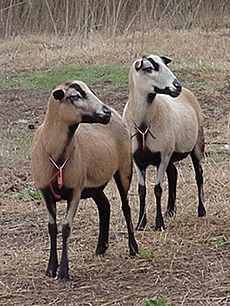
Some sheep are called dairy breeds. These sheep produce more milk and for a longer time. Their milk has more fat and protein than cow's milk. It's great for making cheese and yogurt.
Finally, there are hair sheep. These sheep do not grow wool at all. They are like the very first domesticated sheep. Hair sheep are raised for their meat and skins. They are cheaper to keep because they don't need to be shorn (have their wool cut off). They are also better at resisting parasites and hot weather.
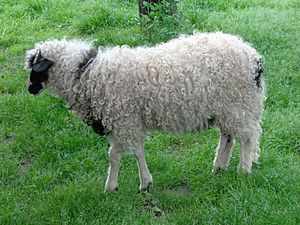
What Sheep Eat
Sheep are herbivores. This means they only eat plants. Most sheep like to eat short grass and other small plants. They usually avoid the taller, woody parts of plants that goats eat. Sheep use their lips and tongues to pick the best parts of plants.
Like all ruminants, sheep have a special digestive system. It has four parts. This helps them break down tough plant parts like stems and leaves. When sheep graze, they chew their food into a ball called a bolus. This goes into the first stomach, the rumen. In the rumen, tiny living things help break down the food.
Later, the sheep brings the food back up to its mouth. This is called chewing its cud. It chews the cud more to break it down further. After the rumen, food goes through two more stomach parts. Then, it goes to the fourth stomach, called the abomasum. This is like a human stomach. After that, the food goes into the intestines for final digestion.
Besides grass, sheep also eat hay, especially in winter. All sheep can live just on grass. Sheep also need minerals. These are often given as special mixes or salt licks. It's important that sheep food is made just for them. Some feeds for other animals, like cattle or pigs, have too much copper. This can be deadly for sheep.
How Sheep Graze
Sheep are active from morning until night. They eat, then stop to rest and chew their cud. The best pasture for sheep has a mix of grasses, clovers, and other plants. Sheep are raised in many different places. These range from specially planted fields to wild lands.
Many common plants are poisonous to sheep. These include cherry, some oaks, tomatoes, yew, rhubarb, potatoes, and rhododendron.
How Sheep Affect Pastures
Sheep eat plants very close to the ground. They can overgraze a pasture much faster than cows. Because of this, many farmers move their sheep often. They rotate the flock through different pastures. This gives the plants time to grow back.
Sheep can both cause and help with the spread of unwanted plants. By disturbing the land, sheep can make it easier for invasive plants to grow. But sheep also like to eat some invasive plants. This makes them useful for conservation grazing. For example, they can eat plants like cheatgrass and spotted knapweed.
Sheep Behavior
Flock Behavior
Sheep are flock animals. This means they like to stay together in groups. This strong desire to follow a leader is why sheep were one of the first animals humans tamed. Sheep do not defend their own areas. But they do tend to stay in a certain home range.
All sheep like to be close to other sheep. They can get stressed if they are alone. In a flock, sheep tend to follow the first one that moves. Sheep that are related often stay together within a larger flock. Sheep can also learn to stay in one specific pasture. This is called "hefting." Lambs learn this from their mothers.
Flock behavior is usually seen in groups of four or more sheep. If there are fewer sheep, they might not act the same way. Sheep are prey animals. Their main way to stay safe is to run away from danger. If a sheep is cornered, it might charge or stomp its hooves. This is especially true for mothers with newborn lambs.
In places where sheep have no natural predators, they don't show strong flocking behavior.
Herding Sheep
Farmers use flocking behavior to keep sheep together. This is helpful on pastures without fences. It also makes it easier to move them. Shepherds often use herding dogs to help. Sheep love food. So, they often come to people who feed them. People moving sheep can use this by leading them with buckets of food.
How Smart Are Sheep?
People often think sheep are not very smart. Their flocking behavior and tendency to panic can make them seem difficult. But studies show that sheep are about as smart as cattle.
Sheep can recognize individual human and sheep faces. They can remember them for years! They can also tell how another sheep is feeling just by looking at its face. If you are patient, sheep can learn their names. Many sheep are trained to be led by a halter for shows. Some sheep have even shown problem-solving skills. There are stories of sheep rolling on their backs to get over cattle grids!
Sheep Sounds
Sheep make different sounds like bleats, grunts, rumbles, and snorts.
- Bleating ("baaing") is mostly for staying in touch. Mothers and lambs use it to find each other. Each sheep's bleat sounds a little different. Bleating can also mean a sheep is stressed or impatient. But sheep are usually quiet when they are in pain.
- Grunting sounds can be made by pregnant ewes during labor.
- Rumbling sounds are made by rams when they are trying to attract ewes. Ewes might also make similar rumbling sounds with their newborn lambs.
- A snort is a quick breath out through the nose. It can mean aggression or a warning. Startled sheep often snort.
Sheep Senses
Sheep get stressed when they are alone. This stress goes down if they can see themselves in a mirror. This shows that seeing other sheep makes them feel safer.
Taste is very important for sheep. It helps them choose what to eat. They prefer sweet and sour plants. They usually avoid bitter ones. Touch and sight also help them choose plants based on how juicy or how they grow.
Sheep Reproduction and Life Cycle
Sheep have a similar way of having babies to other herd animals. One ram usually mates with a group of ewes. Most sheep breed during certain times of the year. But some can breed all year long. Ewes can usually have babies when they are six to eight months old. Rams can breed when they are four to six months old.
Ewes have a cycle about every 17 days. During this time, they give off a scent and show they are ready to mate.
After mating, a ewe is pregnant for about five months. Giving birth usually takes one to three hours. Most sheep have one or two lambs at a time. Some breeds have more.
After birth, ewes and lambs might be put in small pens. These "lambing jugs" help farmers watch the ewes. They also help the mother and lamb bond.
Sometimes, ewes need help giving birth. Farmers might help pull or move the lambs. After birth, the ewe usually licks the lamb clean. Most lambs stand up within an hour. They then drink their mother's first milk, called colostrum. This milk is very important for their health. Lambs that don't drink this milk or are rejected by their mother need help to survive. They might be bottle-fed or given to another ewe.
When lambs are a few weeks old, they get "lamb marking." This includes ear tagging, tail docking, and castrating male lambs not meant for breeding. Vaccinations are also given. Ear tags help identify each sheep. Tail docking helps prevent problems like flystrike. Castration is done to male lambs not used for breeding. These procedures are done when the lambs are very young to reduce pain.
Who Hunts Sheep?
Besides diseases, predators are a big threat to sheep. Sheep cannot defend themselves well. Even if they survive an attack, they might die from injuries or fear. Predators are a serious problem in many parts of the world. In the United States, predators caused over one-third of sheep deaths in 2004. But some islands have almost no sheep predators.
Canids (like dogs and wolves) cause most sheep deaths worldwide. Other animals that sometimes hunt sheep include:
- Cats (like cougars)
- Bears
- Birds of prey (like eagles)
- Ravens
- Wild pigs
Farmers use many ways to protect their sheep. Old ways include shepherds staying with the flock, using livestock guardian dogs, and keeping sheep in barns or fenced areas. These methods are still used today. Electric fences and keeping sheep in pens at night are also common.
More modern ways include using guns, traps, and poisons to kill predators. But today, these methods are often managed by government groups.
Since the 1970s, farmers have started using more non-deadly ways to protect sheep. They use livestock guardian dogs again. They also use donkeys and guard llamas. These animals protect the sheep in the same way guardian dogs do. Sometimes, sheep are pastured with larger animals like cattle or horses. These bigger animals can help scare away predators. Farmers also use motion-activated lights and noisy alarms to scare predators away.
Why Sheep Are Important to Humans
Sheep are a big part of farming around the world. But other animals like pigs, chickens, and cows are now more important for food. China, Australia, India, and Iran have the largest sheep flocks today. They provide wool and meat for their own countries and for export. Countries like New Zealand have smaller flocks but export a lot of sheep products.
Sheep also help many local economies. This can be for special markets like organic food. In many developing countries, sheep are part of farming just for the family. They are not always raised for trade.
Domestic sheep give us many useful things:
- Wool: This was one of the first fabrics. But today, wool prices are lower because of cheap man-made fabrics. For some farmers, it costs more to shear the sheep than they earn from the wool. Wool is also used for things like insulation.
- Meat: Selling meat is now the most profitable part of the sheep industry. But people eat much less sheep meat than chicken, pork, or beef.
- Sheepskin: This is used for clothes, shoes, rugs, and other items.
- Byproducts: After sheep are processed for meat, other parts are used. Sheep fat (tallow) is used for candles and soap. Bones and cartilage are used for carved items, glue, and gelatin. Sheep intestines can be used for sausage casings. Lamb intestines are used for surgical stitches and strings for musical instruments. Even sheep droppings have been used to make paper!
- Lanolin: This is a waterproof, fatty substance from sheep's wool. It is used in many cosmetics and other products.
Sheep as Food
Sheep meat and milk were some of the first important foods for humans. This was after people started farming instead of just hunting. Sheep meat is called either mutton or lamb.
- Mutton comes from older sheep, usually at least two years old.
- Lamb comes from younger sheep, less than a year old.
Today, the countries that eat the most sheep meat are the Arab States of the Persian Gulf, New Zealand, Australia, Greece, Uruguay, the United Kingdom, and Ireland. People in these countries eat a lot of sheep meat each year. Sheep meat is also popular in France, Africa, the Middle East, India, and parts of China. This often happens in places with a long history of raising sheep.
In some countries, like the U.S., people eat very little sheep meat. They might prefer more expensive cuts of lamb, like lamb chops or leg of lamb.
Sheep's milk is not often drunk fresh. But it is very popular for making cheese and yogurt. Sheep have only two teats. They produce less milk than cows. But sheep's milk has much more fat, solids, and minerals than cow's milk. This makes it perfect for making cheese.
Famous cheeses made from sheep milk include Feta from Bulgaria and Greece, Roquefort from France, Manchego from Spain, and Pecorino Romano from Italy. Yogurts can also be made from sheep milk. Many of these products are now sometimes made with cow's milk, especially outside their home countries. Sheep milk has lactose, which can affect people who are lactose intolerant.
Sheep in Science

Sheep are usually too big and reproduce too slowly to be perfect for all research. But they have been important in some science areas. The Roslin Institute in Edinburgh, Scotland used sheep for genetics research. This led to amazing discoveries.
In 1995, two ewes named Megan and Morag were the first mammals cloned from special cells. A year later, a sheep named Dolly became "the world's most famous sheep." She was the first mammal cloned from an adult cell. After Dolly, two other sheep, Polly and Molly, were the first mammals to be cloned and also have new genes added.
Domestic sheep are sometimes used in medical research. They help scientists study the heart and blood system. Pregnant sheep are also used to study human pregnancy. They help researchers learn how poor nutrition or lack of oxygen affects unborn babies. In studies about behavior, sheep have been used to understand how faces are recognized. Their way of recognizing faces is similar to humans.
Images for kids
-
A flock of Australian White hair sheep in Mudgegonga, Victoria, Australia. This is a new breed of hair sheep suited for the hot and varied Australian climate
-
Flock of sheep in South Africa (2015)
-
Shorn sheep for sale, Kashgar Market
-
Ancient Greek red-figure ram-head rhyton, about 340 BC
-
Jesus is shown as "The Good Shepherd," with the sheep being Christians.
See also
 In Spanish: Oveja para niños
In Spanish: Oveja para niños


